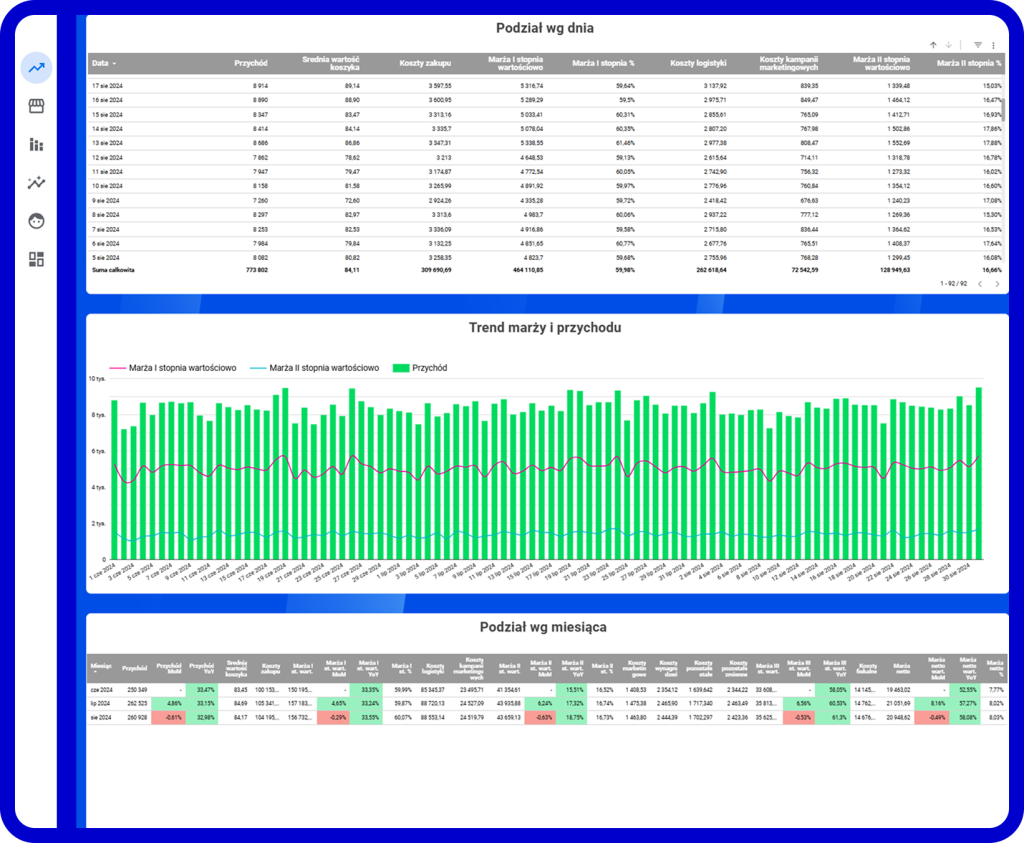Every e-commerce owner knows the feeling. The ads are working, the traffic on the site is growing, the number of orders looks promising. And yet, when the moment of financial summary comes, it turns out that the profit is far from expectations. The margin is melting under the weight of marketing costs, returns and inefficient logistics.
Is it possible to sell more without falling into the trap of rising costs?
Challenges in e-commerce decision making
Siloed data and various forms of reporting
Recall the moment when you tried to compare the results of an ad campaign with sales data. Meta Ads data doesn't match Google Analytics, Shopify shows something else, and you don't know where the truth lies. Each data source has its own reporting methods, which leads to inconsistencies.
Compiling data and creating reports on a daily basis is a reality for every marketer and analyst - but it's a time-consuming task that could be better spent on real business development.
The problem of data silos affects both growing and already established e-commerce stores. As a result, companies manually export data from various analytics systems into CSV files and then combine them in Excel or Google Sheet - which is not only time-consuming, but also error-prone and difficult to scale.
Fear of integration
Many e-commerce owners know that their systems need to be integrated, but are afraid that transferring data to modern tools will be costly and complicated. We often hear: “After all, I can crank it all out in Excel.” Yes, but only until the scale of the business gets out of control.
That's when chaos, errors in analysis and inefficient marketing budget management occur. Lack of integration is a problem that in the long run leads to greater losses than the initial cost of implementing modern tools.
Excel analytics makes sense for small-scale operations - when operating on hundreds of orders per month, manual work may be sufficient. However, as the company grows and the number of customers increases, manual processes become more time-consuming and error-prone.
What's more, the subsequent integration of systems when a company reaches large scale can be much more costly and time-consuming. Meanwhile, more technologically agile companies can get ahead of us, optimizing their operations faster and more efficiently.
Lack of visibility of actual margin and long-term effectiveness
Imagine that you invest in an advertising campaign that at first glance looks profitable - it brings in high revenues. However, after a few months you find that most of the orders came from customers who quickly made returns or bought products with minimal margins.
Companies that don't take into account actual costs often lose money, even if their sales are growing.
Without a full analysis of margins, return costs and long-term customer value (LTV), marketing decisions can lead to a situation where the most profitable campaigns actually generate losses.
How to solve these problems using company data?
Often entrepreneurs think that to improve analytics and optimize sales, they need to perform costly technological transformations. Meanwhile, the key lies not in reinventing the wheel, but in making smarter use of the data the company already has. All it takes is proper organization and integration of this information to get a more complete picture of the business and make smarter decisions.
Data centralization
Integrating sources into a single data warehouse (e.g., BigQuery) avoids problems associated with silos. This ensures that all key information (campaign costs, sales, returns, margins) is available in one place, in real time.
Consistent analytics system
With the right technology, data from different platforms can be combined to create a unified picture. For example, if GA4 shows different results than Meta Ads, a reconciliation model can be used to account for actual conversion paths by combining information from both sites.
Margin tracking and reporting automation
Using business intelligence tools such as Looker Studio, Power BI, Tableau, for example, automates reporting and saves dozens of hours of work per month. Decision makers have access to up-to-date data without having to involve analysts.
To make it even easier to monitor actual margin on products and sales channels, use the Ecommerce Margin Calculator. Find out how simple it is to analyze profitability in your e-commerce business.

Automated reports can take into account not only revenue, but also net margin, allowing you to optimize marketing spending. If a channel generates high revenues but low margins, it can be adjusted or replaced with a more profitable one.
Predictions of long-term performance, a strategy for years to come
Machine learning models can predict the LTV of customers, allowing you to optimize campaigns for not only short-term conversion, but also long-term profitability. By analyzing purchase patterns, order frequency and traffic sources, you can identify customers with the highest value potential and focus marketing efforts specifically on them.
Advanced algorithms help determine which acquisition channels generate users with the highest LTV, enabling precise allocation of advertising budgets. For example, if predictive analysis indicates that customers acquired from an email marketing campaign are more valuable in the long term than those from display ads, you can adjust your marketing strategy, directing more resources to more effective channels.
In addition, predictions allow better management of customer relationships by personalizing communications and special offers. Machine learning models can pinpoint when a customer is likely to make their next purchase, allowing you to send them a tailored offer at the optimal time, increasing the likelihood of conversion and building long-term loyalty.
Case Study: Our support that helped increase profits
Problem
Our client, a fast-growing e-commerce store selling accessories for phones and other mobile devices, faced a major challenge in managing data effectively. Lack of integration between key systems - GA4, Meta Ads and ERP - meant that the operations team was spending hours manually processing data.
Every day, it was necessary to manually export reports to Excel, where data from different sources was merged and analyzed. This was a tedious process, prone to errors and causing delays in decision-making.
In addition, the analysis was based mainly on revenue, without in-depth insight into the actual margin of individual products and categories, which resulted in misguided marketing decisions and errors in advertising budget allocation - for a long time, advertising campaigns were run for products that had the highest return rates!
Solution
Building a data warehouse (BigQuery) – we implemented a central system that combined data from GA4, Meta Ads and ERP into a single, consistent data warehouse. This gave the team access to standardized, up-to-date information in real time, eliminating the need for manual data processing.
Automated dashboards in Looker Studio - We designed interactive dashboards to track key metrics such as cost per conversion, campaign profitability and product margin.
Reports are generated automatically, allowing the team to focus on analyzing and optimizing activities instead of wasting time on manual reporting.
User LTV prediction - we implemented machine learning models that analyze data about customers, their behavior and purchase history. This made it possible to predict the long-term value of customers and segment groups with the highest profitability potential.
This allowed fine-tuning the marketing strategy and allocating budgets to the most effective sales channels.
Results:
- the marketing team spends 1 less day per month on manual reporting.
- Real profit (after campaign costs and margin) increased by 10%
Summary
Increasing e-commerce sales without reducing margins is possible through effective data management. Centralizing data, automating reporting and accurately tracking margins allows you to make better business decisions.
If you want to learn how in your company data can work for the success of your organization - contact us!




























